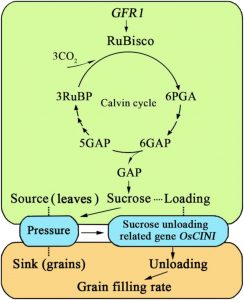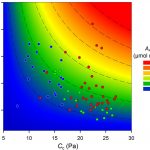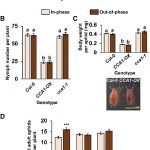Improving Grain Filling Rate in Rice
Poor grain filling by hybrid japonica rice (Oryza sativa) is a major agricultural problem. It has previously been reported that the rice  accession Ludao, a wild-type japonica rice grown naturally in the Liangyungang region of China, exhibited a high grain-filling rate and could be selected as a parent for improving the grain plumpness of hybrid japonica rice. Liu et al. (10.1104/pp.19.00413) have studied this unique accession to understand the genetic basis and molecular mechanism of the grain-filling rate with the ultimate goal of developing a breeding strategy for higher quality and higher yielding hybrid japonica rice. By studying two accessions that vary in rate of grain filling, the authors identified seven quantitative trait loci (QTL) that dictate the rate of grain filling. One of these QTL was identified as the GRAIN-FILLING RATE1 (GFR1) gene. The authors subsequently conducted haplotype association analysis to mine the elite alleles of GFR1 among 117 rice accessions. They observed that GFR1 was constitutively expressed and encoded a membrane-localized protein. The allele of the rice accession Ludao (GFR1Ludao) improved the grain-filling rate of rice by increasing Rubisco initial activity in the Calvin cycle. Moreover, the increased expression of a cell wall invertase gene in a near isogenic line expressing GFR1Ludao promoted the unloading of Suc during the rice grain-filling stage. A yeast two-hybrid assay indicated that the Rubisco small subunit interacts with GFR1, possibly in the regulation of the rice grain-filling rate. Breeding experiments confirmed that favorable alleles of GFR1 can be used to further improve the grain-filling rate of hybrid japonica rice.
accession Ludao, a wild-type japonica rice grown naturally in the Liangyungang region of China, exhibited a high grain-filling rate and could be selected as a parent for improving the grain plumpness of hybrid japonica rice. Liu et al. (10.1104/pp.19.00413) have studied this unique accession to understand the genetic basis and molecular mechanism of the grain-filling rate with the ultimate goal of developing a breeding strategy for higher quality and higher yielding hybrid japonica rice. By studying two accessions that vary in rate of grain filling, the authors identified seven quantitative trait loci (QTL) that dictate the rate of grain filling. One of these QTL was identified as the GRAIN-FILLING RATE1 (GFR1) gene. The authors subsequently conducted haplotype association analysis to mine the elite alleles of GFR1 among 117 rice accessions. They observed that GFR1 was constitutively expressed and encoded a membrane-localized protein. The allele of the rice accession Ludao (GFR1Ludao) improved the grain-filling rate of rice by increasing Rubisco initial activity in the Calvin cycle. Moreover, the increased expression of a cell wall invertase gene in a near isogenic line expressing GFR1Ludao promoted the unloading of Suc during the rice grain-filling stage. A yeast two-hybrid assay indicated that the Rubisco small subunit interacts with GFR1, possibly in the regulation of the rice grain-filling rate. Breeding experiments confirmed that favorable alleles of GFR1 can be used to further improve the grain-filling rate of hybrid japonica rice.



